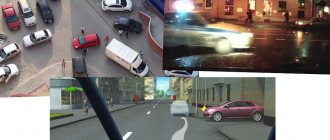Contrary to popular belief, the Road Traffic Regulations (TRAF) do not say anything about using the lane for fixed-route vehicles on weekends. Paragraph 18.2 of the traffic rules states: “On roads with a lane for route vehicles, marked with signs 5.11.1, 5.13.1, 5.13.2, 5.14, the movement and stopping of other vehicles (except for school buses and vehicles used in as a passenger taxi, as well as cyclists - if the lane for fixed-route vehicles is located on the right) on this lane.”
Article on the topic Striped flight. In what cases can you drive on a dedicated lane?
Description in traffic rules
It is considered in all driving schools. However, some of them spend very little time explaining it, since it rarely occurs in real conditions. Because of this, students do not remember it, and problems arise later.
Road signs should not be underestimated, as they are all important - even those that carry additional information. They are especially necessary in large cities, where the roads consist of several lanes and there is always a huge flow of cars moving along them. Thanks to the signs, the organization of traffic becomes more clear.
“Working days”, to be more precise, in essence is not a sign, but an information plate. It is rectangular, and on its white background there are 2 intersecting hammers. Its meaning is as follows: the action applies only on working days of citizens, that is, from Monday to Friday, with the exception of holidays.
What important issues are associated with the use of this sign?
- Installation is carried out only in conjunction with any sign and indicates that it is valid only on weekdays. It is not found anywhere on its own. For example, in a parking lot or along the road, there is a sign “Parking prohibited”, and under it the designation “Working days”. This means that stopping or parking your car here is prohibited only during this period.
- “Working days” does not apply to holidays customary in Russia, as well as to weekends. Thus, the plate carries additional information. This means that she clarifies the meaning of another sign. Such designations are not set individually. Even though they are additional, their security function is still significant.
Bottom line
If signs 5.11.1 “Road with a lane for route vehicles”, 5.13.1 and 5.13.2 “Exit onto a road with a lane for route vehicles”, 5.14 “Lane for route vehicles” or sign 3.1 “ Entry is prohibited”, and also if there are additionally signs “Saturdays, Sundays and holidays”, “Days of the week” (specifically indicating Saturday and Sunday), “Validity times” (indicating Saturday and Sunday and time), then when leaving such a streak on the weekend, prepare to pay a fine - 3 thousand rubles in Moscow and St. Petersburg, 1.5 thousand rubles in other cities of Russia (clause 1.1 of Article 12.17 of the Code of Administrative Offenses of the Russian Federation).
Duration of action
So, on what days the sign is valid is now clear. However, over what distance does its action extend?
In fact, it's simple.
Since the sign is always located together with any sign, it means that they will operate at the same distance.
For example, there is a “No overtaking” sign nearby. Its duration will be from 00:00 on Monday until Friday, when the arrows will show 23:59.
Generally speaking, “No Overtaking” is canceled:
- after the end of the zone of all restrictions or only overtaking.
- the nearest intersection,
- the designation “Beginning of a settlement” or its end, but only on a white background.
The latter option is extremely rare, since this sign is almost never installed on the highway. Its need in such an area is minimal due to minimal traffic congestion.
Therefore, specifically for the road sign in question, there is no predetermined zone in which it is valid. It is formed based on which sign is next to it.
You can also receive a fine for going to a designated area on weekends
The Russian Ministry of Internal Affairs has dotted the i's on the issue of how to properly use dedicated lanes for public transport on weekends. Let us remind you that regions have the right to decide at the local level when to allow travel on “separate lanes” for ordinary cars: for example, in Moscow, on some roads you can only drive on them on Sunday.
With the spread of dedicated lanes on roads, a number of motorists are faced with the question of how to use them correctly.
Everything is clear with the punishment for traveling on prohibited days: so, according to Parts 1.1 and 1.2 of Art. 12.17 of the Code of Administrative Offenses of Russia, the movement of vehicles in the lane for fixed-route vehicles or stopping on the specified lane in violation of traffic rules is punishable by a fine of 1.5 thousand rubles, and for Moscow and St. Petersburg - a fine of 3 thousand rubles.
But here's what to do with the markings: looking at how drivers of both ordinary cars and taxis move out and enter the lane, despite the continuous line without breaks, you involuntarily ask the question - is it possible to do this?
On forums on social networks, motorists assure: since it’s a day off, that means the markings shouldn’t work, after all, they serve to isolate public transport from the flow. One of the capital’s drivers, who was driving along a dedicated lane on a day off, thought so too. When she began to go to the right, the motorist quickly changed lanes to the left across the solid line. He was immediately stopped by a traffic police inspector and issued a fine for a violation for failure to comply with the requirements of horizontal markings 1.1.
According to Part 1 of Art. 12.16 of the Code of Administrative Offenses of Russia, such a violation entails a warning or the imposition of an administrative fine in the amount of five hundred rubles. The disgruntled driver is perplexed: for what?
For clarification on how the “dedicated line” works on weekends, Gazeta.Ru turned to the Russian Ministry of Internal Affairs, where this issue was finally clarified.
“Horizontal markings 1.1 of Appendix 2 to the traffic rules indicate the boundaries of the roadway into which entry is prohibited; crossing it is prohibited. For failure to comply with horizontal marking requirements, administrative liability is provided for in Part 1 of Art. 12.16 of the Code of Administrative Offenses of Russia, which entails a warning or the imposition of an administrative fine in the amount of five hundred rubles. The effect of sign 5.14 of the Russian Traffic Regulations “Lane for route vehicles” in combination with plate 8.5.2, which indicates that the sign is valid only on weekdays, applies to the lane above which it is located.
Horizontal markings must not be crossed at any time. Administrative liability is provided for non-compliance with the requirements,” says the response from the Russian Ministry of Internal Affairs. Thus, it turns out that even when cars are allowed to enter the “dedicated lane,” they can only enter and exit it if there is a gap.
Expert and human rights activist Ravil Akhmetzhanov told Gazeta.Ru that the response of the Ministry of Internal Affairs, despite its validity, raises a number of questions that could put the department in a difficult position. He assures that until recently, traffic police inspectors did not issue fines for such violations, but now the number of such fines is growing rapidly.
“Why, quite recently, did not traffic police inspectors prosecute drivers who crossed this marking on weekends, when sign 8.5.2 made the “Lane of Route Vehicles” sign inoperative? - Akhmetzhanov is perplexed.
— Probably because every driver makes a conclusion for himself: if a dedicated lane is intended for public transport only on weekdays, then only sign 5.14, which was used to justify the ban, is of primary importance.
Consequently, on weekends, entry into such a lane is not prohibited, so marking line 1.1 does not separate the main roadway from the lane into which the sign does not prohibit entry. It must be assumed that those responsible for making decisions had the same opinion as the drivers, and therefore no one was held accountable for crossing this line as valid only on weekdays. Since the received response from the Ministry of Internal Affairs and many decisions on fines for crossing this line, of which I am aware, indicate a change of opinion, we can wait for developments.”
The expert draws attention to the fact that in Appendix 2 to the Russian Traffic Regulations there is no mention that the markings may not be valid for any period of time. Which also correlates with the response of the Ministry of Internal Affairs. At the same time, he believes that control over the correct use of road markings and signs is currently seriously weakened.
“From the decisions made by various persons in combination with an inspection of the places of violations, we can conclude that many offenses are recorded in the presence of serious shortcomings in the organization of traffic. You can see dedicated lanes that you can enter at the very beginning, in the absence of any signs or markings, for driving along which fines will be issued in the future,” the expert said.
In turn, resident of the Guild of Driving Schools of Russia Sergei Lobarev, in a conversation with Gazeta.Ru, admitted that even a law-abiding driver can get confused in such a situation. And he promised that driving schools would try to explain and discuss such nuances with students.
“Considering that the marking line allows drivers to orient themselves and predict the movement of neighboring cars, including at high speeds, failure to follow the marking rules can lead to an emergency and the death of road users,” Lobarev said.
What to do if you are working within the range of the sign
Situations with this sign are different, as it is often used. It happens that a sign is installed on the road to your place of work, or in the parking lot. What to do then? How long does it last and how?
- “No traffic” and “Working days”. Under such conditions, a sign prohibiting further movement will be in effect for all vehicles on weekdays. However, people who work in this place can drive through at any time, including on weekends, but provided that it is a working day for the person.
- “Entry prohibited” and “Working days”. Under such conditions, the movement will be organized as well. It is prohibited to enter a certain area on weekdays, that is, it is allowed only on Saturday and Sunday, as well as on official holidays.
This restriction does not apply to people who work in the area covered by these signs.
They can go there on any days, if for them these are work days. Also, the restriction does not apply to route vehicles. The sign is also found in other situations, but they do not apply to the entrance to the place of work. As for its effect when approaching a place of work, it is worth noting that the restriction does not apply to people who work there. Consequently, the fine is provided under such conditions only for persons who do not work or live in such places.
What to look for?
First of all, you need to pay attention to what signs are installed above the allocated lane.
The above signs, installed above the strip, can be used with certain plates that determine the period of validity of the sign:
- plate 8.5.2 “Working days” indicates that the signs are valid only on working days - from Monday to Friday, on weekends and holidays, movement on the “dedicated lane” is allowed.
- plate 8.5.6 “Validity time” means that the signs prohibit driving in the dedicated lane only on weekdays during the time period indicated on the plate. On weekends, as well as at other times, you can drive in a dedicated lane.
- plate 8.5.3 “Days of the week” indicates the days of the week on which it is forbidden to drive on the dedicated road; on other days it is permitted.
- plate 8.5.7 “Validity time” prohibits movement on the “separate lane” only on the day of the week and at the time indicated on it.
You cannot enter a dedicated lane if there is additionally one of the signs above it: 8.5.1 “Saturdays, Sundays and holidays”, 8.5.4 “Validity hours” or 8.5.5 “Working days”.
Validity period of the “Working days”/”Weekends” sign
“Working hours” is an information designation that explains additional information under the main sign, indicating the time and days of the week. The following categories are distinguished:
Weekends and holidays.
The sign indicates a vehicle for which travel is prohibited during this time period. For example: January 2 from 00:00 to 04:00.
The sign is only active on specific weekdays.
It is indicated on what day the ban or permit operates.
Sanctions
Any sign located on the road establishes certain rules or limits something. Therefore, there are fines for non-compliance. “Working days” also restricts certain aspects of traffic, so violating it will result in a fine.
For violation of the "Days of Operation" sign, the punishment will be the same as that provided for failure to comply with the sign installed along with it.
On weekends, punishment for such a violation can only be received if this day is considered a working day throughout the country due to the pre-holiday days. In other situations, if the inspector issues a protocol for a violation during this period, it can be challenged in court.
Penalties for non-compliance with “Working days”:
- The plate is used in conjunction with the “Parking” sign on a blue background. This means that it is prohibited on working days and allowed on weekends or holidays. Parking for a long time in such a place entails a fine of 1,500 rubles. If such a violation occurred in a city of federal significance, then the monetary penalty will be 3,000 rubles.
- The sign is located under the “No Traffic” sign. You will have to pay 500 rubles. The sign prohibits all vehicles from entering the road. Violation of this restriction, which is set as “No Entry” (better known as a “brick” among drivers), carries the same penalty. However, it does not apply to route vehicles.
Do not forget that the restrictions set by these road signs are only valid from Monday to Friday, excluding holidays. Therefore, on weekends the ban loses its force. Consequently, it will then be impossible to punish the driver for failure to comply with this rule.
The “Days of Operation” sign is practically not installed on the highway. It is necessary to remember it and understand the principle of operation, first of all, for motorists who most often drive in urban environments. Violations can lead to a fine, and in large cities, to the evacuation of vehicles if they are parked in the wrong place at the wrong time.
In the face of constant problems with parking, for employees of a particular company, a sign always guarantees hassle-free access to their place of work, as well as free parking spaces during rush hour.
The “Working Days” sign is a small sign below the main sign. In common parlance - a road sign “with hammers” or “two hammers”.
What does the paid parking sign “10 15 20” mean?
According to the letter of the law, the driver is not allowed to charge a fee for parking a car if the corresponding zone is not marked with a paid parking sign. At the same time, the motorist also bears administrative responsibility, ignoring the parking rules, as well as paying for it. For violation, the driver can be legally fined. Moreover, both regular traffic police officers and automatic surveillance cameras are involved in drawing up violation protocols. Depending on the circumstances, penalties in the form of fines or warnings may be applied.











